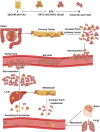Unveiling the dynamics of circulating tumor cells in colorectal cancer: from biology to clinical applications
- PMID: 39539964
- PMCID: PMC11557528
- DOI: 10.3389/fcell.2024.1498032
Unveiling the dynamics of circulating tumor cells in colorectal cancer: from biology to clinical applications
Abstract
This review delves into the pivotal role of circulating tumor cells (CTCs) in colorectal cancer (CRC) metastasis, focusing on their biological properties, interactions with the immune system, advanced detection techniques, and clinical implications. We explored how metastasis-competent CTCs evade immune surveillance and proliferate, utilizing cutting-edge detection and isolation technologies, such as microfluidic devices and immunological assays, to enhance sensitivity and specificity. The review highlights the significant impact of CTC interactions with immune cells on tumor progression and patient outcomes. It discusses the application of these findings in clinical settings, including non-invasive liquid biopsies for early diagnosis, prognosis, and treatment monitoring. Despite advancements, challenges remain, such as the need for standardized methods to consistently capture and analyze CTCs. Addressing these challenges through further molecular and cellular research on CTCs could lead to improved interventions and outcomes for CRC patients, underscoring the importance of unraveling the complex dynamics of CTCs in cancer progression.
Keywords: cancer cell biology; circulating tumor cells; colorectal cancer; liquid biopsy; metastasis.
Copyright © 2024 Dompé, Chojnowska, Ramlau, Nowicki, Alix-Panabières and Budna-Tukan.
Conflict of interest statement
The authors declare that the research was conducted in the absence of any commercial or financial relationships that could be construed as a potential conflict of interest.
Figures



Similar articles
-
The Role of Circulating Tumor Cells as a Liquid Biopsy for Cancer: Advances, Biology, Technical Challenges, and Clinical Relevance.Cancers (Basel). 2024 Mar 31;16(7):1377. doi: 10.3390/cancers16071377. Cancers (Basel). 2024. PMID: 38611055 Free PMC article. Review.
-
Circulating Tumor Cells: Origin, Role, Current Applications, and Future Perspectives for Personalized Medicine.Biomedicines. 2024 Sep 20;12(9):2137. doi: 10.3390/biomedicines12092137. Biomedicines. 2024. PMID: 39335650 Free PMC article. Review.
-
Nanotechnology-Assisted Isolation and Analysis of Circulating Tumor Cells on Microfluidic Devices.Micromachines (Basel). 2020 Aug 14;11(8):774. doi: 10.3390/mi11080774. Micromachines (Basel). 2020. PMID: 32823926 Free PMC article. Review.
-
Nanostructure embedded microchips for detection, isolation, and characterization of circulating tumor cells.Acc Chem Res. 2014 Oct 21;47(10):2941-50. doi: 10.1021/ar5001617. Epub 2014 Aug 11. Acc Chem Res. 2014. PMID: 25111636 Free PMC article. Review.
-
Circulating Tumor Cells Versus Circulating Tumor DNA in Colorectal Cancer: Pros and Cons.Curr Colorectal Cancer Rep. 2016 Jun;12(3):151-161. doi: 10.1007/s11888-016-0320-y. Epub 2016 Apr 7. Curr Colorectal Cancer Rep. 2016. PMID: 27516729 Free PMC article.
Cited by
-
Unveiling the dual role of circulating tumor cells in colorectal cancer immunotherapy: a comprehensive review of biomarker utility and immune microenvironment crosstalk.Front Immunol. 2025 Jun 6;16:1591359. doi: 10.3389/fimmu.2025.1591359. eCollection 2025. Front Immunol. 2025. PMID: 40547026 Free PMC article. Review.
-
Exploring the Role of Cellular Interactions in the Colorectal Cancer Microenvironment.J Immunol Res. 2025 Apr 11;2025:4109934. doi: 10.1155/jimr/4109934. eCollection 2025. J Immunol Res. 2025. PMID: 40255905 Free PMC article. Review.
References
-
- Aktar S., Hamid F. B., Gamage S. M. K., Cheng T., Parkneshan N., Lu C. T., et al. (2023a). Gene expression analysis of immune regulatory genes in circulating tumour cells and peripheral blood mononuclear cells in patients with colorectal carcinoma. Int. J. Mol. Sci. 24, 5051. 10.3390/ijms24055051 - DOI - PMC - PubMed
Publication types
LinkOut - more resources
Full Text Sources

